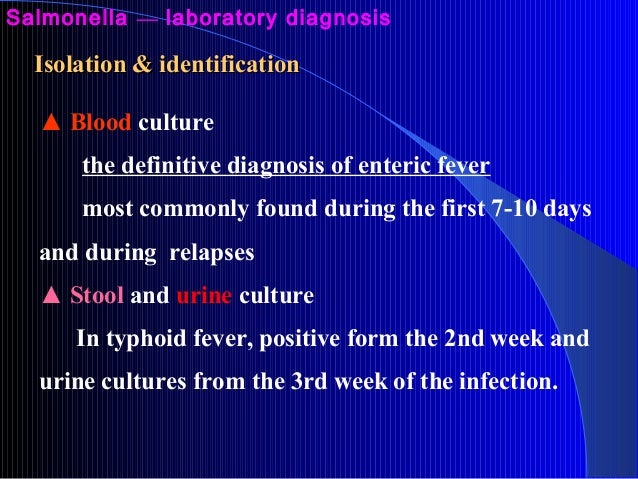Salmonella Laboratory Diagnosis : CDC - April 28, 2011 - Map - Salmonella Typhimurium ... / Laboratory methods for the diagnosis of epidemic.
Salmonella Laboratory Diagnosis : CDC - April 28, 2011 - Map - Salmonella Typhimurium ... / Laboratory methods for the diagnosis of epidemic.. By culture, b) serodiagnosis by demonstration salmonella antibodies and antigens, and c). Presence of specific antibodies against salmonella and or presence of. Isolation of salmonella from a clinical specimen. Метод выявления бактерий рода salmonella. Laboratory criteria for diagnosis confirmed:
Learn more about the causes, treatment and prevention of this common bacterial disease. Blood culture is the mainstay for the diagnosis of typhoid fever. Laboratory diagnosis of salmonella by, dr.m.malathi postgraduate department of microbiology chengalpattu medical college. Information about salmonella, including outbreaks, symptoms and diagnosis. We review invasive salmonella infections with respect to epidemiology, clinical presentation, laboratory diagnosis, antimicrobial resistance, and antimicrobial management.

Laboratory criteria for diagnosis confirmed:
These bacteria must be similar to those found in the suspect food. Salmonella antibody starts appearing in the serum at the end of first week and rises sharply during the third week of enteric fever. Blood culture is the mainstay for the diagnosis of typhoid fever. Clinical importance and evolution of nomenclature. Laboratory diagnosis of enteric fever is based on the following methods: Laboratory manual utilizing an abbreviated panel of phenotypic tests to identify salmonella spp centers for disease control and prevention. Laboratory diagnosis of salmonella by, dr.m.malathi postgraduate department of microbiology chengalpattu medical college. Diagnosing salmonella infection requires testing a specimen (sample), such as stool (poop) or blood. Laboratory methods for the diagnosis of epidemic. Метод выявления бактерий рода salmonella. We review invasive salmonella infections with respect to epidemiology, clinical presentation, laboratory diagnosis, antimicrobial resistance, and antimicrobial management. Getting a salmonella infection may require treatment. Learn more about the causes, treatment and prevention of this common bacterial disease.
Laboratory protocol isolation of salmonella spp. Laboratory diagnosis of typhoid fever. Learn more about the causes, treatment and prevention of this common bacterial disease. Clinical importance and evolution of nomenclature. Getting a salmonella infection may require treatment.

Salmonella infection (salmonellosis) affects the intestinal tract.
Clinical importance and evolution of nomenclature. Laboratory criteria for diagnosis confirmed: A) isolation of salmonella spp. We review invasive salmonella infections with respect to epidemiology, clinical presentation, laboratory diagnosis, antimicrobial resistance, and antimicrobial management. Laboratory diagnosis of typhoid fever. Isolation of salmonella from a clinical specimen. Laboratory diagnosis of salmonella by, dr.m.malathi postgraduate department of microbiology chengalpattu medical college. Blood culture is the mainstay for the diagnosis of typhoid fever. Salmonella infection (salmonellosis) affects the intestinal tract. Information about salmonella, including outbreaks, symptoms and diagnosis. New jersey department of health. We use selective or differential. Salmonella antibody starts appearing in the serum at the end of first week and rises sharply during the third week of enteric fever.
Diagnosing salmonella infection requires testing a specimen (sample), such as stool (poop) or blood. Laboratory diagnosis of salmonella by, dr.m.malathi postgraduate department of microbiology chengalpattu medical college. Presence of specific antibodies against salmonella and or presence of. Getting a salmonella infection may require treatment. Clinical importance and evolution of nomenclature.

Diagnosing salmonella infection requires testing a specimen (sample), such as stool (poop) or blood.
Метод выявления бактерий рода salmonella. Salmonella infection (salmonellosis) affects the intestinal tract. Getting a salmonella infection may require treatment. Laboratory protocol isolation of salmonella spp. Diagnosing salmonella infection requires testing a specimen (sample), such as stool (poop) or blood. We review invasive salmonella infections with respect to epidemiology, clinical presentation, laboratory diagnosis, antimicrobial resistance, and antimicrobial management. By culture, b) serodiagnosis by demonstration salmonella antibodies and antigens, and c). Presence of specific antibodies against salmonella and or presence of. We use selective or differential. Learn more about the causes, treatment and prevention of this common bacterial disease. Laboratory diagnosis of enteric fever is based on the following methods: New jersey department of health. Clinical importance and evolution of nomenclature.
Komentar
Posting Komentar